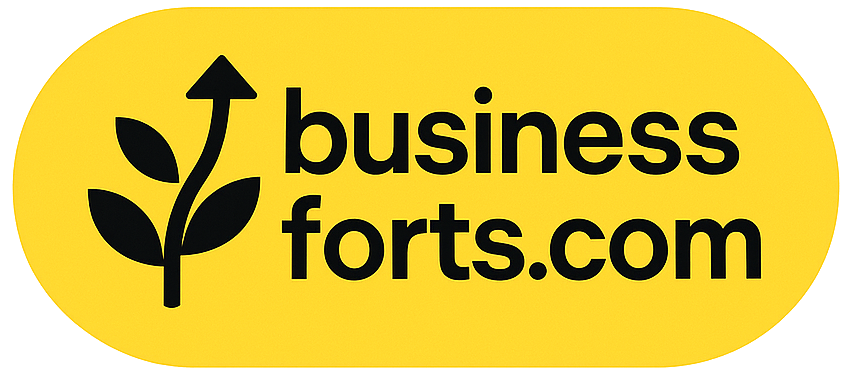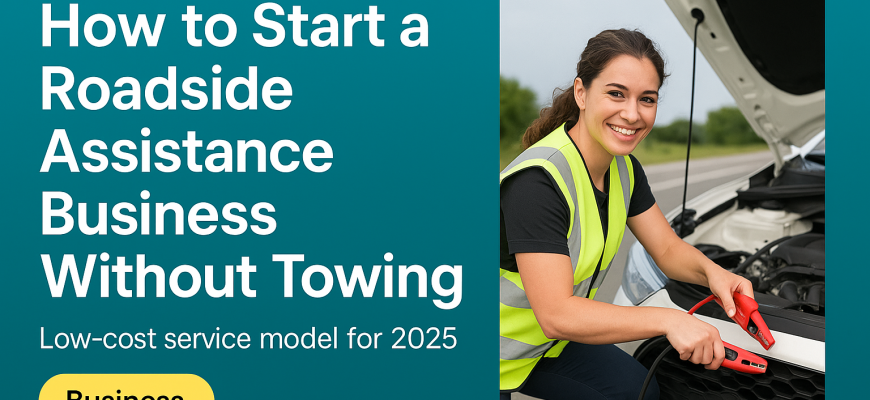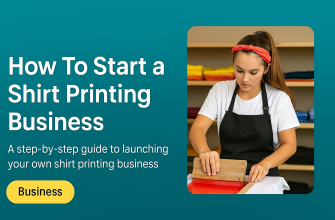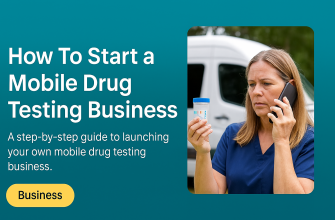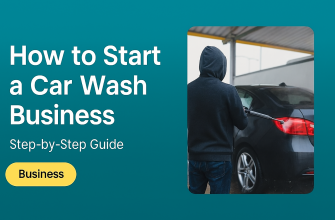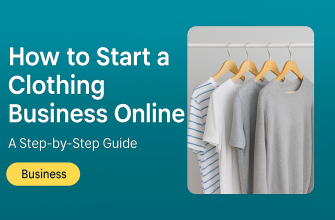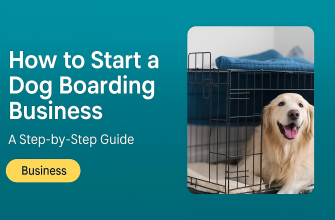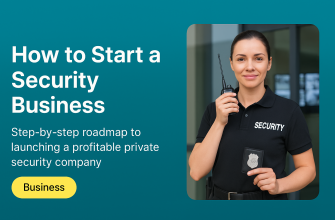Starting your own business can feel daunting, especially in an industry like roadside assistance that’s traditionally full of tow trucks and heavy equipment. But here’s some good news: you don’t need a tow truck or a huge budget to start a roadside assistance business. In fact, focusing on services without towing is an accessible, low-cost way to launch your entrepreneurial journey. A non-towing roadside assistance business helps drivers with common minor breakdowns on the spot – things like jump-starting a dead battery, changing a flat tire, delivering fuel, or unlocking a car – without hauling the vehicle away. This means you can start small (even solo), with just a reliable vehicle and some basic tools, and still make a big difference for stranded motorists.
As a business coach who’s seen many women thrive as entrepreneurs, I’m excited to walk you through this step-by-step guide. It’s normal to feel nervous when starting out, but remember: every big business started small, and with each step you’ll gain confidence. Let’s dive into how you can get your roadside assistance venture off the ground, one step at a time, no tow truck required!
- Step 1: Identify Common Roadside Needs (and the Services You’ll Offer)
- Step 2: Do Your Research and Get the Necessary Training
- Step 3: Gather Your Tools and Equipment (Budget-Friendly Essentials)
- Step 4: Take Care of Licensing and Insurance
- Step 5: Define Your Pricing and Service Packages
- Step 6: Market Your Business and Build Your Customer Base
- Step 7: Plan for Growth – Scaling and Partnering for the Future
- You’re Ready to Roll!
Step 1: Identify Common Roadside Needs (and the Services You’ll Offer)
Begin by deciding what services you’ll provide. Most roadside assistance calls are for simple, on-site fixes that you can handle without any towing. For example, drivers frequently deal with:
-
Dead batteries – needing a quick jump-start.
-
Flat tires – requiring a tire change or inflation.
-
Empty fuel tanks – a few gallons of gas can save their day.
-
Lockouts – keys locked in the car (a basic lockout kit can solve this).
These are some of the most common roadside emergencies that can turn a driver’s day upside down. The great thing is that you can solve them right where the car is, getting the driver back on the road without a tow. Focus on mastering these core services first – they will be the bread-and-butter of your business.
Ask yourself: Which services am I comfortable doing now, and which do I need to learn? If you’re not yet confident changing a tire or jump-starting a car, don’t worry – we’ll cover training next. The key in this first step is to clearly define the help you’ll offer. Having a clear list of services makes it easier to plan your equipment, training, and marketing. Plus, it lets potential customers know exactly how you can assist them.
Encouragement: You might be thinking, “Can I really do this?” Yes, you can! None of these common tasks are rocket science. With a bit of practice and instruction, you’ll be ready to handle a dead battery or flat tire like a pro. Confidence comes with experience – and you’re about to get plenty of that.
Step 2: Do Your Research and Get the Necessary Training
Every successful business starts with a bit of homework. Research your local market and learn what it takes to operate in your area. This means checking out who else is offering roadside assistance nearby and what they charge, as well as understanding your potential customers. Look for information on how busy certain services are – for instance, in a cold climate, battery jump-starts might spike in winter, while in a rural area tire fixes or fuel deliveries might be in higher demand. Studying the competition and market trends will help you spot opportunities and set yourself apart.
Next, let’s talk about training. You do not need to be a master mechanic to start a roadside assistance business, but you should be comfortable with the basics. If you’ve never performed some of the services from Step 1 (like using a jack or a lockout kit), now is the time to learn. You can practice with a friend or family member’s car, watch free how-to videos online, or even take a local workshop. There are also certification courses for roadside assistance that cover vehicle recovery techniques, safety procedures, and customer service. In fact, many established roadside companies require their providers to undergo training in these areas – so having some training under your belt can boost your credibility.
Important skills and knowledge areas to focus on:
-
Vehicle basics: How to jump-start various types of vehicles safely, change a tire, check for common issues like loose battery cables or overheating.
-
Safety protocols: How to stay safe when working roadside – e.g. using hazard lights, cones, or flares, and proper positioning of vehicles.
-
Customer service: Helping someone who’s stranded can be stressful for them – a friendly, calm demeanor is a huge asset. Practice communicating clearly and empathetically.
-
Local regulations: Research if any special permits are needed for tasks like unlocking cars (some places consider this locksmith work). Also, note any laws about operating a mobile service business in your area.
Encouragement: Don’t let the need for training discourage you. These skills are very learnable. Think of it this way – every new skill you pick up is an investment in yourself and your business. You might even enjoy the process of becoming a roadside “hero” equipped with all the tricks to rescue a driver in need. Take it one skill at a time. You’ve got this!
Step 3: Gather Your Tools and Equipment (Budget-Friendly Essentials)
One of the best parts of a non-towing roadside business is that you don’t need heavy machinery – just some affordable tools. You might even have a few of these already. Below is a list of budget-friendly essential equipment to get you started (you can always add more as your business grows):
-
Jump-Starter Pack: A portable battery “jump box” to revive dead car batteries. Modern jump-starters are small, powerful, and don’t even require a second vehicle – a fully charged pack can jump multiple cars in a day. This saves both you and your customer time.
-
Tire Change Tools: A reliable car jack and lug wrench are must-haves for flat tires. (Many newer cars don’t come with a jack included, so carrying your own is vital.) Add a tire pressure gauge and maybe a portable air compressor to inflate tires on the spot – it’s often more convenient to top up a low tire than to put on the spare.
-
Gas Can: People run out of fuel more often than you’d expect, and you can be their lifesaver. Carry a sturdy 2–5 gallon gas can (ideally one with a spill-proof spout or funnel). It’s a simple, inexpensive item that can save the day for a stranded driver.
-
Lockout Kit: This is a set of slim tools to help unlock cars when the keys are inside. A typical lockout kit includes an inflatable wedge to gently pry the door, and a long reach tool or rod to hit the unlock button or door lock. It’s surprisingly easy to use with a little practice. (Just be sure to verify if any license is required to perform automotive lockouts in your region.)
-
Basic Tool Kit: Keep a small toolbox with things like screwdrivers, pliers, adjustable wrench, duct tape, and jumper cables. You’d be amazed how often a loose bolt, a dead battery terminal, or other minor issue can be fixed with simple hand tools. A flashlight or headlamp is essential too for night calls.
-
Safety Gear: Your safety and your customer’s safety come first. Always have a reflective safety vest (you want to be visible to other drivers), a pair of work gloves, and some traffic cones or emergency triangles. A high-visibility vest and cones will protect you while you work, especially on a busy road or at night. Also, consider a first-aid kit – hopefully you won’t need it, but it’s good to be prepared.
All of the above can be obtained relatively cheaply. You don’t need the fanciest, top-of-the-line gear when starting out. For instance, you can get a decent jump-starter and jack without breaking the bank. Look for sales or even quality second-hand tools. The goal is to have reliable equipment that lets you do the job effectively. As your business grows and brings in profit, you can always upgrade items later.
Encouragement: Starting on a tight budget? That’s okay! Focus on the must-haves first (like a jump pack, jack, and gas can). You can add more specialized tools over time. Many entrepreneurs begin with just the basics and a “can-do” attitude. Remember, it’s not about having a fancy setup – it’s about being resourceful and helping people with what you have. And you’re doing exactly that!
Step 4: Take Care of Licensing and Insurance
Now let’s get the paperwork in order. Setting up your business legally and protecting it with insurance is a crucial step that will save you headaches later. It might not be the most thrilling part, but it’s definitely important.
Business Registration & Licensing: Decide how you want to register your business. Many solo entrepreneurs start as a sole proprietorship (which is simplest) and later transition to an LLC (Limited Liability Company) for added protection, but you can choose what fits you. Registering your business and choosing a proper structure will legitimize your operation and protect your personal assets in the long run. Check your city, county, or state requirements for business licenses. You might need a general business license to operate, or specific permits for roadside assistance services – this varies by location, so do a bit of research with your local authorities. If you’ve created a fun business name, you may also need to file a “Doing Business As” (DBA) name registration. All of these steps ensure you’re operating within the law. And don’t forget to set up a business bank account once you’re official – it helps in keeping finances clear and separate from personal funds.
Insurance: Insurance is your safety net – for both you and your customers. At the very least, you’ll want a general liability insurance policy. This covers things like accidental damage or injuries that could happen during a service call (for example, if a customer’s vehicle gets a scratch, or you accidentally hurt someone’s property). Additionally, because you’ll be driving to assist people, make sure your vehicle is properly insured for business use. A personal auto insurance policy often does not cover commercial activities; you may need to get a commercial auto policy or a rider on your policy to cover you when you’re working. It’s worth discussing with your insurance agent and being fully transparent about your business use of the vehicle. If you plan to have employees in the future, you’ll eventually need workers’ compensation insurance as well, but if it’s just you to start, that may not be required yet.
Depending on your area and services, there might be other insurance or bonding to consider. For example, some roadside assistance contractors get bonded especially if they handle lockouts (to assure customers they’re trustworthy). Also, if you partner with motor clubs or insurance companies later, they might require certain coverage limits (e.g., a higher liability limit) – so getting that in place now positions you for those opportunities.
Encouragement: Tackling legal and insurance steps can feel a bit out of your comfort zone, especially if you’re new to entrepreneurship. But think of it as building a strong foundation for your business. Once this is done, you can operate with peace of mind, knowing you’re protected if something goes wrong. It’s a one-time (or occasional) effort that pays off in the long run. Don’t hesitate to ask questions from local small business offices or other entrepreneurs – help is out there. You’re not alone in figuring this stuff out!
Step 5: Define Your Pricing and Service Packages
With your services set and tools in hand, it’s time to figure out how you’ll charge for your work. Setting the right pricing strategy is key to both attracting customers and making a profit. Here’s how you can approach it:
-
Research Local Rates: Start by finding out what other roadside assistance providers (especially non-towing ones, if any) in your area charge. You might discover, for example, that a typical jump-start in your region goes for $50, or a tire change for $65. Having a ballpark idea of market rates gives you a baseline. You can often find this info on competitors’ websites or by calling and inquiring as a customer.
-
Consider Your Costs: Calculate what each service costs you in time and resources. Factor in fuel for driving out to the customer, the wear-and-tear on your vehicle, consumables (like fuel you deliver or small parts), and an hourly rate for your time. You want your price to comfortably cover your expenses and provide you a reasonable profit for your effort. Don’t forget to account for the value of being available 24/7 (if you choose to offer round-the-clock help, after-hours service can justify a higher rate).
-
Set Clear, Fair Prices: When starting out, simplicity is your friend. You might set a flat rate for each type of service, or an hourly rate if a job ends up more complex. For instance, you could advertise a menu like: “Jump-start or Battery Service – $50, Tire Change – $60, Fuel Delivery – $50 plus cost of fuel, Lockout Service – $50.” Make sure the customer knows what to expect. If you have to charge extra (say, for long distance travel to reach them, or if a situation is unusual), be upfront about it. Transparency builds trust.
-
Offer Packages or Memberships: To encourage loyalty or cater to frequent customers, you can get creative with packages. For example, a subscription model – drivers pay a small monthly or yearly fee to get a certain number of assistance calls “free” or at a discounted rate. This is similar to how big auto clubs work, but you could tailor it to local customers (maybe partner with local businesses or car dealerships to include your service for their customers). Another idea is offering bundled services: e.g., a “road-trip safety package” that includes a home visit to do a tire pressure check, battery test, and a fuel top-up before a long trip – this could be an extra service you charge for during slow periods. Think about what might appeal to your customer base.
-
Adjust as Needed: It’s perfectly okay (and expected) to tweak your prices as you learn what works. If every customer is happily paying $60 for a tire change and you’re overwhelmed with requests, that might be a sign you can charge a bit more. Conversely, if people often hesitate at your price, you might try a slight reduction or adding more value (like a free check on their other tires or a bottle of water while they wait). Your pricing will find its sweet spot over time.
When you’re just starting with limited capital, it might be tempting to set your prices super low to attract customers. Be careful with that. While you definitely want to be competitive, don’t undervalue your time and expertise. Remember that what you’re offering is convenience and peace of mind at a stressful time for the customer. That is worth a lot. Customers generally don’t mind paying a fair price to someone who shows up quickly at 7 AM when their car won’t start, or at night on a lonely road with a flat tire.
Encouragement: Setting prices can feel like a guess, but you’ll get the hang of it! Trust that you’re providing real value. It’s okay to start with your best estimate and refine as you go. Also, don’t be afraid to charge what you’re worth. Women sometimes feel pressure to give discounts or apologize for charging money – but you’re running a business and you deserve to be paid for your hard work. Think of it this way: the more sustainable your business is financially, the more people you can help in the long run. So, set those prices confidently!
Step 6: Market Your Business and Build Your Customer Base
Now that you’re all set up, it’s time to let the world (or at least your community) know about your roadside assistance service. Marketing might sound scary, but it can be boiled down to this: reach the people who need your help and tell them you’re here for them. You can start small and budget-friendly, using creativity more than cash. Here are some effective ways to attract customers:
-
Social Media Presence: Create a Facebook page and/or Instagram account for your business. These are free and surprisingly powerful. On these pages, you can share useful car tips (like how to prevent battery drain in winter, or a checklist for road trips) and also let people know about your services. This not only advertises your business but also positions you as a helpful, knowledgeable friend in the community. Engaging with your local online community builds trust. (For example, posting automotive tips and highlighting your services on social platforms helps connect you with potential customers.) Invite friends to like and share your page – word can spread fast online.
-
Online Listings and Local SEO: Make sure your business can be easily found when drivers search for help. You should list your service on Google Business (so that when someone Googles “roadside assistance near me,” you pop up on the map). It’s free to create a Google Business profile, where you can list your phone number, hours, and services. Encourage happy customers to leave a Google review – good reviews will boost your visibility and credibility. Additionally, consider listing on other platforms like Yelp or any local directories or apps people use in your area to find services. If you have the ability, a simple website or even a one-page landing site with your contact info and services can be helpful – but to start, a Facebook page and Google listing might suffice.
-
Networking and Partnerships: Don’t underestimate the power of real-world networking. Introduce yourself to local businesses related to automobiles. Visit nearby auto repair shops, tire shops, car dealerships, auto parts stores, even insurance agent offices – and let them know about your services. Often, these businesses get customers or calls that they can’t help with on the spot (for example, a car dealer might get a call from someone whose car broke down off-site). By building relationships, they might refer those folks to you. You could even arrange a referral deal or leave your flyers at their location. Networking within your community not only gets your name out there, it also lends credibility – people trust businesses that are known in the community.
-
Print Materials and Local Ads: Old-school marketing has its place too. Print some business cards to hand out whenever an opportunity arises (you meet someone who says “oh, I sometimes drive long distances,” etc.). You can also create simple flyers to pin on community bulletin boards (libraries, coffee shops, community centers) or to drop off at places like gas stations. Make sure any materials highlight that you offer quick, on-site help without towing, and include your phone number big and bold. If your budget allows, you could advertise in a local newspaper or community newsletter, but that’s optional.
-
Promotions and Word-of-Mouth: Especially as you launch, a promotion can kickstart your customer base. For instance, you might offer an introductory discount – maybe $10 off the first service for new customers or a free secondary service (like a free tire pressure check with every jump-start) in your first month . Another powerful tactic is word-of-mouth: tell family, friends, and neighbors about your new business and ask them to spread the word. You might even incentivize referrals – “Refer a friend and if they use my service, you get a $10 gift card” or something creative. People love to support someone they know, and your personal network can be a great source of early customers. Delivering excellent, friendly service every time is key, because it turns happy customers into ambassadors for your business. Encourage those you help to leave a review or testimonial, or simply to tell others that your service was a lifesaver. A strong reputation is the best marketing you can have.
Encouragement: You might not think of yourself as a “marketing person” – that’s okay! Think of marketing as just sharing your passion and letting people know how you can help them. There are drivers out there right now who would love a reliable, friendly person to call instead of a big, impersonal towing company. By getting the word out, you’re doing them a favor, too. Start with small steps: one social media post, one conversation with a local business, one flyer on a bulletin board. Over time, these efforts compound. And remember, every big brand or busy business once had zero customers. They grew one client at a time, and so will you. Stay positive and be persistent – your community needs the service you provide!
Step 7: Plan for Growth – Scaling and Partnering for the Future
Once you start getting regular customers and you’ve got your operations running smoothly, it’s time to think about the future. How might you expand or streamline your business as it grows? One of the beautiful things about a roadside assistance business (especially one without towing) is that it’s scalable. You can take it as far as you’d like: from a part-time solo gig to a full-fledged company with multiple service vehicles – the choice is yours.
A few growth strategies and opportunities to consider:
-
Geographic Expansion: In the beginning, you might limit your service area to keep things manageable (for example, your town and immediate surroundings). As you gain experience and resources, you can gradually widen your radius. Perhaps you’ll extend services to neighboring towns or an entire region. Expanding your coverage area can bring in more business once you’re ready to handle it. Just ensure to do it gradually – you don’t want to stretch yourself too thin too soon.
-
Adding Team Members: If the calls start rolling in and you find yourself busy (a good problem to have!), consider bringing on help. This could mean hiring another technician to assist customers (maybe someone part-time to cover nights or weekends) or even a dispatcher to field calls if you’re getting a high volume. Hiring trustworthy, skilled people will allow your business to serve more customers at once and reduce burnout on you. Be sure to train any employees in the same friendly, safety-conscious approach that you started with. Your first hires might even be folks you know who have the right skills – or you could specifically aim to mentor and hire other women interested in this line of work, creating a supportive team.
-
Partnerships with Motor Clubs and Insurers: A great way to scale your customer base is by partnering with established organizations in the industry. Many insurance companies and auto clubs (like AAA, Allstate’s motor club, etc.) rely on local contractors for roadside assistance. You can apply or sign up to be a service provider for these networks. What this means is, when a customer with, say, Geico roadside assistance calls for help in your area, the job could be dispatched to you. It often provides a steady stream of calls. The trade-off is that the pay per job might be lower than when you get your own customer directly (since the motor club or app takes a cut), but it can be excellent for volume and keeping busy, especially while you’re building your personal client base. It’s like being on a platform that feeds you gigs. Research the requirements for each (some require certain insurance levels, background checks, or equipment lists – which by this step you likely have covered). Partnering with these larger entities can significantly boost your revenue and reputation.
-
Technology and Apps: As you grow, you might invest in better technology to streamline operations. There are dispatch software systems and apps that can help manage calls, track jobs, and even let customers request service via an app. In the beginning a simple phone and notepad might do, but as volume increases, tech can keep you organized. There are also existing apps where independent roadside providers can make themselves available for on-demand requests (similar to how Uber drivers get ride requests). Being accessible through multiple channels (phone, website, apps, etc.) will help when scaling up.
-
Service Expansion: Right now, you’re focusing on the core non-towing services. In the future, you could expand your service offerings. For instance, maybe you’ll add a mobile mechanic element (handling slightly more complex repairs on-site), or perhaps you’ll decide to eventually incorporate a towing vehicle as your big expansion move. You might also consider selling related products – like carrying replacement batteries or spare tires that you can sell on the spot. Another avenue is to offer safety inspections or preventive check-ups (like a mobile service where you go to customers’ homes to do a quick “car health” report). Listen to your customers – if many people ask, “Do you also do X?” that could be a sign that adding X might be a good growth move.
-
Franchising or Branching Out: If you find great success and develop a strong business model, you might dream bigger! Some entrepreneurs eventually expand to multiple locations or even franchise their concept to others. For example, you could replicate your business in another city by training someone to run it under your brand. Or simply open another branch in a second region while you manage both. This is a longer-term possibility and not something to worry about now, but it shows how far a humble start can potentially go. The sky is the limit.
Through all these growth ideas, one thing remains important: maintaining the quality and reliability of your service. Growth is only beneficial if your customers continue to be happy. So as you scale, keep the personal touch and care that made your business special in the first place.
Encouragement: Think back to why you wanted to start this business. Maybe it’s for financial independence, maybe it’s to prove to yourself (and others) that you can succeed in a new field, or maybe you just love helping people. Whatever that drive is, hold onto it as you grow. Scaling up can be scary, but it’s also an exciting adventure. And you don’t have to rush – some entrepreneurs stay happily solo, and that’s perfectly fine too. This is your business, and you get to define what success looks like. If you do dream of growing big, know that it’s possible. With each happy customer, your reputation builds. With each step you take to partner or expand, you’re paving the way for more opportunities. And as a woman in this industry, you’re also carving out a path for others to follow. There’s a lot of room for innovation and leadership here – why shouldn’t it be you to lead the way?
You’re Ready to Roll!
Stepping into the role of entrepreneur in the roadside assistance world is both a practical and inspiring choice. You’re filling a true need – drivers will always occasionally get stuck and seek help, and you can be the friendly hero who comes to their rescue. What’s more, by doing it without towing, you’re showing that big hearts and smart solutions matter more than big trucks. You’ve learned how to identify the services you can confidently offer, set up your business on solid footing, equip yourself without draining your savings, and reach out to those who need you. Each step of the way, remember that every expert was once a beginner.
For the women entrepreneurs reading this: I especially want you to take this to heart. This might be a male-dominated field, but that’s changing – and you are part of that change. Your dedication, empathy, and perspective are strengths. Some customers will be extra grateful to see a woman professional arrive because it breaks their expectations (in a good way) and often brings a sense of comfort. So wear that uniqueness with pride.
As you start this journey, keep your chin up on the tough days and celebrate the little victories. The first time you get a call from a stranger who found you online, the first thank-you note from someone you helped at 2 AM, the first month you turn a profit – these are huge milestones. Cherish them. They are proof that you’re building something that matters.
With a clear plan, the right tools, and a whole lot of passion, your roadside assistance business can truly go places. I’m rooting for you every step of the way. Now, take a deep breath, believe in yourself, and go make it happen. The road ahead is wide open – and you’re driving your own success!
